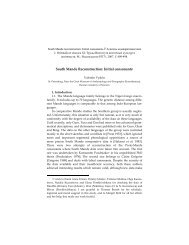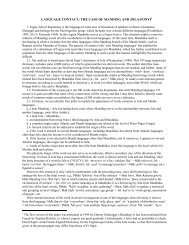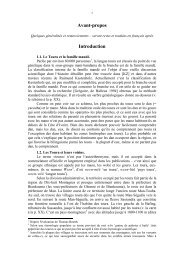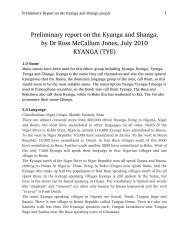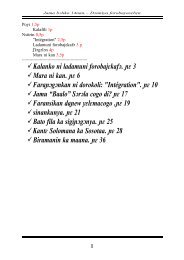Vowel length in the Kakabe language - Langues mandé - ЯзÑки ...
Vowel length in the Kakabe language - Langues mandé - ЯзÑки ...
Vowel length in the Kakabe language - Langues mandé - ЯзÑки ...
- No tags were found...
Create successful ePaper yourself
Turn your PDF publications into a flip-book with our unique Google optimized e-Paper software.
Additionally, <strong>the</strong>re are two predicative markers, tée (negative marker ofhabitualis), and máa (negative perfective marker) – which also have a long vowel:í tée nɔń í dɔǹ ná 50, 110, 502SG NEG.IRR be.able 2SG dance <strong>in</strong>‘You cannot dance’.à máa nàa kúnun 60, 110, 903SG NEG.PRF come yesterday‘He did not come yesterday’InterpretationWe have considered three specific types of vowel <strong>length</strong> attached to differentpositions with<strong>in</strong> a morpheme. In each position <strong>the</strong> vowel <strong>length</strong> is subject to differentrules and has a different phonological status.The contrast “short vs. long vowel” has a status of a phonological opposition <strong>in</strong>its strict sense only <strong>in</strong> non-f<strong>in</strong>al syllables of a morpheme. In this position, nomorphemic boundary <strong>in</strong>side <strong>the</strong> long vowel is possible, which is a strong argument toconsider it as a s<strong>in</strong>gle phoneme and not a comb<strong>in</strong>ation of two identical phonemes.As for <strong>the</strong> f<strong>in</strong>al syllable of a morpheme, generally, only a short vowel can occur<strong>in</strong> this position. Consequently, <strong>the</strong> vowel <strong>length</strong> opposition is not relevant here. Such aconstra<strong>in</strong>t is also attested <strong>in</strong> o<strong>the</strong>r Mande <strong>language</strong>s, for example <strong>in</strong> Bamana andSon<strong>in</strong>ke [Creissels 1994: 49].A phonetically long vowel does, however, occur <strong>in</strong> <strong>the</strong> f<strong>in</strong>al syllable of a def<strong>in</strong>itenoun, it is always accompanied with a special tonal contour. But <strong>the</strong> phonological statusof this <strong>length</strong> is different from that <strong>in</strong> a non-f<strong>in</strong>al syllable. One possibility to def<strong>in</strong>e itsstatus is to consider <strong>the</strong> word-f<strong>in</strong>al long vowel as a comb<strong>in</strong>ation of two vowels. We canassume that <strong>the</strong>re is a morpheme boundary go<strong>in</strong>g just <strong>in</strong>side <strong>the</strong> long vowel – that is, <strong>the</strong>boundary between <strong>the</strong> root of <strong>the</strong> noun and <strong>the</strong> article, and a biphonemic <strong>in</strong>terpretationestablishes itself.However, as was shown above, not every vowel with an article has a long f<strong>in</strong>alvowel. So, it is not <strong>the</strong> article itself that causes <strong>the</strong> <strong>length</strong>en<strong>in</strong>g. This situation also putsunder question <strong>the</strong> existence of a morphemic boundary between <strong>the</strong> root of <strong>the</strong> noun and<strong>the</strong> article <strong>in</strong> <strong>the</strong> plane of expression.As far as this <strong>length</strong>en<strong>in</strong>g is not of lexical or grammatical nature, but belongsra<strong>the</strong>r to <strong>the</strong> plane of expression to which <strong>the</strong> tone contour belongs, <strong>the</strong> long vowelappear<strong>in</strong>g <strong>in</strong> <strong>the</strong> f<strong>in</strong>al syllable should be <strong>in</strong>terpreted as a long allophone of a vowel <strong>in</strong><strong>the</strong> f<strong>in</strong>al syllable. It is true that <strong>the</strong> allophonemic <strong>in</strong>terpretation is relevant only if weconsider <strong>the</strong> three positions separately. O<strong>the</strong>rwise, we would have to equate <strong>the</strong>phonetically long vowel <strong>in</strong> word-f<strong>in</strong>al position with <strong>the</strong> phonologically long vowel of<strong>the</strong> non-f<strong>in</strong>al position. However, <strong>the</strong> dist<strong>in</strong>ction between different positions <strong>in</strong> <strong>Kakabe</strong>seems of higher importance for <strong>the</strong> phonological analysis of this <strong>language</strong>, whichjustifies <strong>the</strong> approach assumed <strong>in</strong> <strong>the</strong> current paper.In any case, <strong>in</strong>dependently of <strong>the</strong> approach that we decide to follow, <strong>the</strong>rerema<strong>in</strong>s <strong>the</strong> fact that <strong>the</strong> contrast “short vs. long vowel” is phonologically irrelevant <strong>in</strong><strong>the</strong> f<strong>in</strong>al position, and a phonetically long vowel <strong>in</strong> <strong>the</strong> f<strong>in</strong>al syllable of def<strong>in</strong>ite nounscorrelates with a specific tonal contour.The third type of vowel <strong>length</strong> is attested <strong>in</strong> monosyllabic morphemes. Let usconsider first <strong>the</strong> two pr<strong>in</strong>cipal parts of speech, <strong>the</strong> verb and <strong>the</strong> noun. Both short and
long vowels are attested <strong>in</strong> this position, but <strong>the</strong> contrast between short and long vowelsdoes not dist<strong>in</strong>guish lexical items (unlike <strong>the</strong> non-f<strong>in</strong>al short and long vowels), butra<strong>the</strong>r grammatical classes of words, i.e. parts of speech. The <strong>length</strong> of <strong>the</strong> vowel <strong>in</strong> <strong>the</strong>only syllable characterizes a class on <strong>the</strong> whole, not each s<strong>in</strong>gle representative of it.Thus, all nouns always have a long vowel if <strong>the</strong>y consist of one syllable. A vowel <strong>in</strong>monosyllabic verbs is shorter than <strong>in</strong> a noun; it is most often semi-long, but it may varyto some extent. So, <strong>the</strong> function of <strong>the</strong> <strong>length</strong> contrast <strong>in</strong> this case can be def<strong>in</strong>ed asclassify<strong>in</strong>g.To illustrate <strong>the</strong> dist<strong>in</strong>ctive power of vowel <strong>length</strong> contrast <strong>in</strong> monosyllabicmorphemes, let us consider <strong>the</strong> follow<strong>in</strong>g m<strong>in</strong>imal pairs (a double letter stands for along vowel, and <strong>the</strong> sign “:” renders a semi-long nature of <strong>the</strong> vowel):Kɔ́: ‘to offer’ (verb) – kɔ́ɔ ‘back’ (noun).Tá: ‘to go away’ – táа ‘fire’ (noun).As for <strong>the</strong> o<strong>the</strong>r parts of speech, <strong>the</strong>ir scarce number <strong>in</strong> our data doesn’t let usmake any certa<strong>in</strong> conclusions about <strong>the</strong> status of vowel <strong>length</strong>. We have nomonosyllabic postpositions or adverbs with a long vowel; all of <strong>the</strong>m have only shortvowels. But <strong>the</strong>re are two conjunctions and two predicative markers with long vowelsapart from all o<strong>the</strong>r conjunctions and predicative markers with short vowels. So,apparently, <strong>in</strong> this case <strong>the</strong> phonological opposition of <strong>length</strong> is relevant.One more question concern<strong>in</strong>g vowel <strong>length</strong> <strong>in</strong> monosyllabic words is how to<strong>in</strong>terpret phonologically <strong>the</strong> “semi-long” vowels <strong>in</strong> monosyllabic verbs. Does <strong>the</strong>expression “semi-long” have any phonological value at all <strong>in</strong> this case? This term wouldbe justified if <strong>the</strong>re were an opposition <strong>in</strong> vowel <strong>length</strong> with three members: long vs.semi-long vs. short vowel. The semi-long vowel of <strong>the</strong> verb does contrast with <strong>the</strong> longvowel of <strong>the</strong> noun, but <strong>the</strong> existence of <strong>the</strong> third member of <strong>the</strong> opposition is ra<strong>the</strong>rdoubtful, because we can not claim with certa<strong>in</strong>ty that <strong>the</strong>re is any part of speech whichhas only short vowel when it is monosyllabic. This question requires fur<strong>the</strong>r data andexam<strong>in</strong>ation.There are <strong>the</strong>refore, <strong>in</strong> relation to <strong>the</strong> vowel <strong>length</strong> <strong>in</strong> <strong>Kakabe</strong>, three positionallyconditioned subsystems, <strong>in</strong> which of <strong>the</strong>m <strong>the</strong> <strong>length</strong> opposition has a different statusand is operated by different rules.BibliographyCreissels, Denis. Aperçu sur les structures phonologiques des langues négro-africa<strong>in</strong>es.Grenoble : EELUG. 1994Diallo, Abdourahmane. Grammaire descriptive du pular du Fuuta Jaloo (Gu<strong>in</strong>ée).Frankfurt am Ma<strong>in</strong> : Peter Lang. 2000.Gérard Dumestre. Le Bambara du Mali: Essai de description l<strong>in</strong>guistique. Paris :INALCO. 1994.Gajdos, Mart<strong>in</strong>a. Praktisches Wörterbuch. Deutcsh – Fulfulde, Fulfulde – Deutsch.Wien. 2000.Kasevich, Vadim. – В. Б. Касевич. Фонологические проблемы общего и восточногоязыкознания. М.: Наука. 1983. [V.B. Kasevich. Phonological issues of generaland oriental l<strong>in</strong>guisitcs. Moscow: Nauka. 1983]Kasevich, Vadim. – В.Б. Касевич. Морфонология. Л: Издательство Ленинградскогоуниверситета. 1986. [V.B. Kasevich. Morphophonology. Len<strong>in</strong>grad: Len<strong>in</strong>gradUniversity Publishers. 1986]
Kodzasov, Sandre & Krivnova, Olga. – С. В. Кодзасов, О. Ф. Кривнова. Общаяфонетика. М.: РГГУ. 2001. [S.V. Kodzasov, O.F. Krivnova. General phonetics.Moscow: Russian State University of Human Studies. 2001.]Н. С. Трубецкой. Основы фонологии. М.: Аспект Пресс. 2000. [N.S. Trubetskoy.Foundations of Phonology. Moscow : Aspect Press. 2000]Valent<strong>in</strong> Vydr<strong>in</strong>e. Le pied métrique dans les langues mandé. Manuscrit.Valent<strong>in</strong> Vydr<strong>in</strong>e. – В. Ф. Выдрин. Фонологический тип и именная морфологияпра-манде // Труды института лингвистических исследований. Том II, часть 2.СПб: Наука 2006, с. 9-252. [The phonological type and <strong>the</strong> nom<strong>in</strong>al morphologyof <strong>the</strong> Proto-Mande. Acta L<strong>in</strong>guistica Petropolitana. Transactions of Institute forL<strong>in</strong>guistic Studies, Vol. II, Part 2. St. Petersburg: Nauka, 2006, pp. 9-252.]G.V. Zubko Dictionnaire Peul (Fula)-Russe-Français. Moscou « Langue Russe ». 1980.Zubko, Gal<strong>in</strong>a & Koval, Anton<strong>in</strong>a. – Зубко, А. И. Коваль. Язык фула. М.: Наука.1986. [G.V. Zubko, A.I. Koval. Fula <strong>language</strong>. Moscow: Nauka. 1986.]



